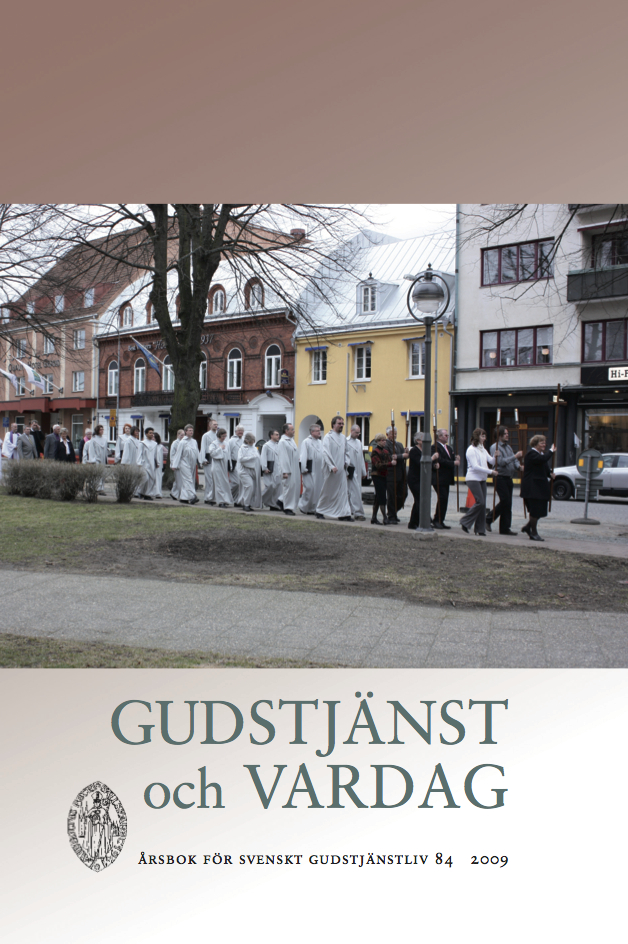Andrum. Avskilda rum för andakt, enskild meditation och ro i vardagens brus
Abstract
Breathing-Spaces. Separate Rooms for Prayer, Meditation and Stillness in the Midst of Everyday Life
During the latest decades, special rooms for meditation and prayer, open to all irrespective of religion or creed, have been accommodated in places of work, hospitals, international airports, schools and higher education to mention a few. The aim of this study is to understand this room as answer to Sweden’s multi-cultural society of today, and to analyze its aesthetical solutions.
In seeking its origin, the Meditation room at the United Nation’s Headquarter in New York distinguishes of great importance. The General Secretary Dag Hammarskjöld was deeply involved with its rearrangement (1957), a quite narrow space originally furnished a few years before. The decoration is composed of an abstract mural with geometric pattern; the few seats consist of a pair of benches, easily removed. What really strikes the visitor entering the room is a rectangular block of iron ore in the mid- dle of the room. On the one way the block is altar-like, on the other its slender shape, location and blank surface makes it non-sacred. It gives an open meaning to the room, at the same time the block is a means of formal concentration.
The influence of the UN Meditation room can be observed at several places (fig. 1; fig. 4). The so-called Breathing-Space (Andrum) of Uppsala University Ångström Laboratory (2001), a sparsely decorated room of few colors, is a representative from the last years. Typically, there is no clear direction or focus, no kind of aisle or table serving as altar. Often you find a block, serving as a point of concentration. The kiblah-direction towards Mekka may be marked discretely with tape on the floor. Elementary forms are often used – a mat with the circle symbolizing both harmony and eter- nity seems to be a favorite, intensifying the room’s diffuse orientation, just like the cushions or easily-removed stools. These characteristics result in an intriguing quality, a solemn room where you feel at ease being on your own.
Information sheets and the University's web page give information on how to use the room. The respect of the other’s silence is pointed out, as the request not to use the room for duties you should attend to at other places, like eating, sleeping or studying. However, you may stay here to recover your breath, meditate or even listen to music, using headphones. The user is recommended to leave the shoes entering the room. That means that the carpet can serve also for the Muslim’s prayer. However, special praying rugs are often found at shelves or cupboards, donated to the room as also often icons and praying books. Similarly a crucifix and altar candles are brought to the room if used for Christian service or mass.
The neutrally designed meditation and praying room form a sharp contrast to the Arlanda Airport Chapel (1993, fig. 2). Belonging to the Church of Sweden, it also gives room for other creeds with different holy books but also liturgical elements and the marking of kiblah. All kind of users come to the chapel: travellers, wedding couples, and people working at the airport, taxi drivers. In the book of visits voices tell about the gratitude for the room; open for all kind of visitors.
Also the funeral chapel is shortly discussed in the article. In the last 50 years, the funeral chapel’s neutral adornment has become a norm since this room should be possible to use for all kind of ceremonies. However, a multi-religious use demands more than open symbols. At the hospital of Karolinska, Solna there is a room accommodated for the Muslim ritual cleansing of the dead body (2004). The design with en extra door in the window also enables a defilation through the sparsely furnished room when many people are attending the ceremony. (fig. 7).
The special room for meditation and prayer is often found in basements. If not hidden, this location has a kind of secluded effect (fig. 3.) At Malmö Högskola the Pacific room (Stilla rum) is found in the middle of the students' library, a cube of glass visible for all (fig. 5). In that way, the room stands as a physical manifestation, reminding that what takes place here is important for many people. You might say there’s no specific use of this specific room. Nevertheless it’s a room worth attention that even may need to be protected.
(For the figures, see the separate section "Bildark" in this volume.)
Key words: creed and Swedish multi-cultural society, funeral chapel, meditation room, neutral adornment and symbols
Downloads
Publicerad
Nummer
Sektion
Licens
© författarna, Laurentius Petri Sällskapet för svenskt gudstjänstliv samt Artos & Norma bokförlag. Det är tillåtet att kopiera och använda material ur Svenskt Gudstjänstliv för forskningsändamål om källan anges. För övriga ändamål kontakta respektive artikelförfattare samt förlaget. Särskilda restriktioner kan gälla för bildmaterial.


